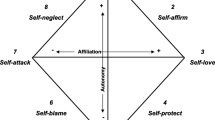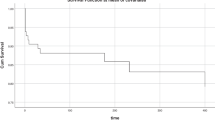Abstract
Anorexia nervosa (AN), a severe mental disorder with an onset during adolescence, has been found to be difficult to treat. Identifying variables that predict long-term outcome may help to develop better treatment strategies. Since body image distortion and weight gain are central elements of diagnosis and treatment of AN, the current study investigated perceptual body image distortion, defined as the accuracy of evaluating one’s own perceived body size in relation to the actual body size, as well as total and early weight gain during inpatient treatment as predictors for long-term outcome in a sample of 76 female adolescent AN patients. Long-term outcome was defined by physical, psychological and psychosocial adjustment using the Morgan–Russell outcome assessment schedule as well as by the mere physical outcome consisting of menses and/or BMI approximately 3 years after treatment. Perceptual body image distortion and early weight gain predicted long-term outcome (explained variance 13.3 %), but not the physical outcome alone. This study provides first evidence for an association of perceptual body image distortion with long-term outcome of adolescent anorexia nervosa and underlines the importance of sufficient early weight gain.
Similar content being viewed by others
References
American Psychiatric Association (2013) Diagnostic and statistical manual of mental disorders (DSM-5), 5th edn. American Psychiatric Association, Washington, DC
Steinhausen H-C (2002) The outcome of anorexia nervosa in the 20th century. Am J Psychiatry 159(8):1284–1293
Herpertz-Dahlmann B, Hebebrand J, Müller B, Herpertz S, Heussen N, Remschmidt H (2001) Prospective 10-year follow-up in adolescent anorexia nervosa—course, outcome, psychiatric comorbidity, and psychosocial adaptation. J Child Psychol Psychiatry 42(05):603–612
Zipfel S, Löwe B, Reas DL, Deter H-C, Herzog W (2000) Long-term prognosis in anorexia nervosa: lessons from a 21-year follow-up study. Lancet 355(9205):721–722
Strober M, Freeman R, Morrell W (1997) The long-term course of severe anorexia nervosa in adolescents: survival analysis of recovery, relapse, and outcome predictors over 10–15 years in a prospective study. Int J Eat Disord 22(4):339–360. doi:10.1002/(sici)1098-108x(199712)22:4<339:aid-eat1>3.0.co;2-n
Vall E, Wade TD (2015) Predictors of treatment outcome in individuals with eating disorders: a systematic review and meta analysis. Int J Eat Disord 48(7):946–971
Key A, George CL, Beattie D, Stammers K, Lacey H, Waller G (2002) Body image treatment within an inpatient program for anorexia nervosa: the role of mirror exposure in the desensitization process. Int J Eat Disord 31(2):185–190
Banfield SS, McCabe M (2002) An evaluation of the construct of body image. Adolescence 37(146):373–393
Cash TF, Wood CC, Phelps KD, Boyd K (1991) New assessments of weight-related body image derived from extant instruments. Percept Mot Skills 73(1):235–241
Keizer A, Smeets MAM, Dijkerman HC, Van den Hout M, Klugkist I, Van Elburg A, Postma A (2011) Tactile body image disturbance in anorexia nervosa. Psychiatry Res 190(1):115–120
Jacobi C, Hayward C, de Zwaan M, Kraemer HC, Agras WS (2004) Coming to terms with risk factors for eating disorders: application of risk terminology and suggestions for a general taxonomy. Psychol Bull 130(1):19–65
Keel PK, Dorer DJ, Franko DL, Jackson SC, Herzog DB (2005) Postremission predictors of relapse in women with eating disorders. Am J Psychiatry 162(12):2263–2268
Ben-Tovim DI, Walker K, Gilchrist P, Freeman R, Kalucy R, Esterman A (2001) Outcome in patients with eating disorders: a 5-year study. Lancet 357(9264):1254–1257
Waldman A, Loomes R, Mountford VA, Tchanturia K (2013) Attitudinal and perceptual factors in body image distortion: an exploratory study in patients with anorexia nervosa. J eat disord 1(1):1–9
Probst M, Vandereycken W, Vanderlinden J, Van Coppenolle H (1998) The significance of body size estimation in eating disorders: its relationship with clinical and psychological variables. Int J Eat Disord 24(2):167–174
Hennighausen K, Enkelmann D, Wewetzer C, Remschmidt H (1999) Body image distortion in anorexia nervosa—is there really a perceptual deficit? Eur Child Adolesc Psychiatry 8(3):200–206
Cornelissen PL, Johns A, Tovée MJ (2013) Body size over-estimation in women with anorexia nervosa is not qualitatively different from female controls. Body Image 10(1):103–111. doi:10.1016/j.bodyim.2012.09.003
Skrzypek S, Wehmeier P, Remschmidt H (2001) Body image assessment using body size estimation in recent studies on anorexia nervosa. A brief review. Eur Child Adolesc Psychiatry 10(4):215–221
Casper RC, Halmi KA, Goldberg SC, Eckert E, Davis J (1979) Disturbances in body image estimation as related to other characteristics and outcome in anorexia nervosa. Br J Psychiatry 134(1):60–66
Castro J, Gila A, Puig J, Rodriguez S, Toro J (2004) Predictors of re-hospitalization after total weight recovery in adolescents with anorexia nervosa. Int J Eat Disord 36(1):22–30
Sala L, Mirabel-Sarron C, Pham-Scottez A, Blanchet A, Rouillon F, Gorwood P (2012) Body dissatisfaction is improved but the ideal silhouette is unchanged during weight recovery in anorexia nervosa female inpatients. Eat Weight Disord 17(2):e109–e115. doi:10.1007/bf03325334
Roy M, Meilleur D (2010) Body image distortion change during inpatient treatment of adolescent girls with restrictive anorexia nervosa. Eat Weight Disord-Stud Anorex, Bulim Obes 15(1–2):108–115
Hartmann A, Wirth C, Zeeck A (2007) Prediction of failure of inpatient treatment of anorexia nervosa from early weight gain. Psychother Res 17(2):218–229
Le Grange D, Accurso EC, Lock J, Agras S, Bryson SW (2014) Early weight gain predicts outcome in two treatments for adolescent anorexia nervosa. Int J Eat Disord 47(2):124–129
Doyle PM, Le Grange D, Loeb K, Doyle AC, Crosby RD (2010) Early response to family-based treatment for adolescent anorexia nervosa. Int J Eat Disord 43(7):659–662
Mewes R, Tagay S, Senf W (2008) Weight curves as predictors of short-term outcome in anorexia nervosa inpatients. Eur Eat Disord Rev 16(1):37–43
Lock J, Couturier J, Bryson S, Agras S (2006) Predictors of dropout and remission in family therapy for adolescent anorexia nervosa in a randomized clinical trial. Int J Eat Disord 39(8):639–647
Raykos BC, Watson HJ, Fursland A, Byrne SM, Nathan P (2013) Prognostic value of rapid response to enhanced cognitive behavioral therapy in a routine clinic sample of eating disorder outpatients. Int J Eat Disord 46(8):764–770
Garber A, Le Grange D (2015) Refeeding Young Patients with Anorexia Nervosa. Eat Disord Rev, 26(1). http://eatingdisordersreview.com/nl/nl_edr_26_1_1.html
Lay B, Jennen-Steinmetz C, Reinhard I, Schmidt MH (2002) Characteristics of inpatient weight gain in adolescent anorexia nervosa: relation to speed of relapse and re-admission. Eur Eat Disord Rev 10(1):22–40
Lund BC, Hernandez ER, Yates WR, Mitchell JR, McKee PA, Johnson CL (2009) Rate of inpatient weight restoration predicts outcome in anorexia nervosa. Int J Eat Disord 42(4):301–305
Carter JC, Mercer-Lynn KB, Norwood SJ, Bewell-Weiss CV, Crosby RD, Woodside DB, Olmsted MP (2012) A prospective study of predictors of relapse in anorexia nervosa: implications for relapse prevention. Psychiatry Res 200(2):518–523
Accurso EC, Ciao AC, Fitzsimmons-Craft EE, Lock JD, Le Grange D (2014) Is weight gain really a catalyst for broader recovery?: the impact of weight gain on psychological symptoms in the treatment of adolescent anorexia nervosa. Behav Res Ther 56:1–6
Dilling H, Mombour W, Schmidt M (2000) klinisch-diagnostische Leitlinien [International Classification of psychiatric disorders, ICD-10-Chapter V (F), clinical and diagnostic guidelines]. Huber, Bern
Englert E, Jungmann J, Lam L, Wienand F, Poustka F (1998) Die basisdokumentation kinder-und jugendpsychiatrie. Spektrum 27(5):129–146
Slade PD, Russell G (1973) Awareness of body dimensions in anorexia nervosa: cross-sectional and longitudinal studies. Psychol Med 3(02):188–199
Smeets MA, Smit F, Panhuysen GE, Ingleby JD (1998) Body perception index: benefits, pitfalls, ideas. J Psychosom Res 44(3):457–464
Horn K (1998) Eine manuelle Methode zur Erfassung von Körperschemastörungen bei Anorexie- Patienten: Ergebnisse einer Kontrollgruppenuntersuchung. PhD thesis, Technische Universität, Dresden
Kromeyer-Hauschild K, Wabitsch M, Kunze D, Geller F, Geiss H, Hesse V, von Hippel A, Jaeger U, Johnsen D, Korte W (2001) Percentiles of body mass index in children and adolescents evaluated from different regional German studies. Monatsschrift fur Kinderheilkunde 149(8):807–818
Morgan H, Hayward A (1988) Clinical assessment of anorexia nervosa. The Morgan-Russell outcome assessment schedule. Br J Psychiatry 152(3):367–371
Herpertz-Dahlmann B, Remschmidt H (1993) Depression in anorexia nervosa at follow-up. Int J Eat Disord 14(2):163–169
Benninghoven D, Tetsch N, Kunzendorf S, Jantschek G (2007) Body image in patients with eating disorders and their mothers, and the role of family functioning. Compr Psychiatry 48(2):118–123
Tozzi F, Sullivan PF, Fear JL, McKenzie J, Bulik CM (2003) Causes and recovery in anorexia nervosa: the patient’s perspective. Int J Eat Disord 33(2):143–154
Fichter MM, Quadflieg N, Hedlund S (2006) Twelve year course and outcome predictors of anorexia nervosa. Int J Eat Disord 39(2):87–100
Cash TF, Deagle EA (1997) The nature and extent of body-image disturbances in anorexia nervosa and bulimia nervosa: a meta-analysis. Int J Eat Disord 22(2):107–126
Baron-Cohen S, Jaffa T, Davies S, Auyeung B, Allison C, Wheelwright S (2013) Do girls with anorexia nervosa have elevated autistic traits? Mol Autism 4(1):24. doi:10.1186/2040-2392-4-24
Gillberg IC, Rastam M, Gillberg C (1995) Anorexia nervosa 6 years after onset: part I personality disorders. Compr Psychiatry 36(1):61–69
Rosen JC (1997) Cognitive-behavioral body image therapy. Handb Treat Eat Disord 2:188–201
Trottier K, Carter JC, MacDonald DE, McFarlane T, Olmsted MP (2014) Adjunctive graded body image exposure for eating disorders: a randomized controlled initial trial in clinical practice. Int J Eat Disord 48(5):494–504
Acknowledgments
This work was supported by the Deutsche Forschungsgemeinschaft (SFB 940), the Swiss Anorexia Nervosa Foundation and the Roland-Ernst Stiftung für Gesundheitswesen.
Author information
Authors and Affiliations
Corresponding author
Ethics declarations
Financial disclosures
In the last 2 years, Dr. Roessner has received lecture fees from Eli Lilly, Janssen-Cilag, Medice and Novartis, and was a member of advisory boards of Eli Lilly and Novartis.
Conflicts of interest
All other authors reported no biomedical financial interests or potential conflicts of interest.
Ethical approval
This study was approved by the local Institutional Review Board.
Informed consent
All participants (and if underage their guardians) gave written informed consent.
Rights and permissions
About this article
Cite this article
Boehm, I., Finke, B., Tam, F.I. et al. Effects of perceptual body image distortion and early weight gain on long-term outcome of adolescent anorexia nervosa. Eur Child Adolesc Psychiatry 25, 1319–1326 (2016). https://doi.org/10.1007/s00787-016-0854-1
Received:
Accepted:
Published:
Issue Date:
DOI: https://doi.org/10.1007/s00787-016-0854-1




